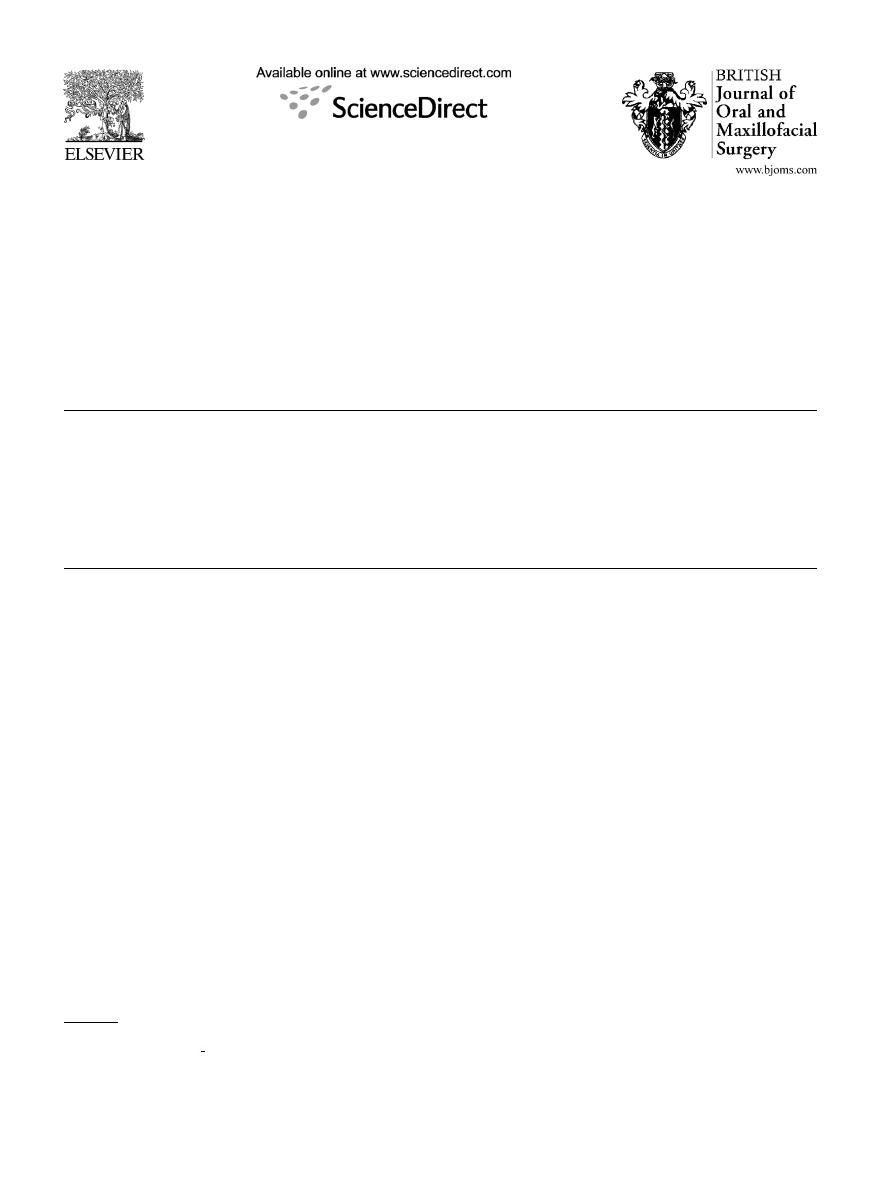
British Journal of Oral and Maxillofacial Surgery 45 (2007) 571–572
Short communication
Gunshot injuries to the parotid gland: Patterns of
injury and primary management
Omer W. Majid
Department of Oral & Maxillofacial Surgery, College of Dentistry, Mosul University, Nineveh, Iraq
Accepted 16 March 2006
Available online 5 May 2006
Abstract
We have treated 16 patients with gunshot injuries to the cheek, 10 of whom had damage to the parotid. There were nine men and one woman,
mean age 40 (range 15–65). All injuries were high velocity, and eight had other injuries. We followed them up for a month; three patients
required further operation, three had facial palsy, and one lost his hearing on that side.
© 2006 The British Association of Oral and Maxillofacial Surgeons. Published by Elsevier Ltd. All rights reserved.
Keywords: Parotid duct injuries; Facial gunshot injuries; Parotid fistula
Introduction
Gunshot injuries to the buccal region of the face may be
associated with many complications because of the complex
anatomy of the area. The parotid gland is one of the struc-
tures that may be involved. Damage to the parotid is often
overlooked or underestimated in patients with facial injuries.
Failure to recognise such injuries may result in sialoceles,
cutaneous fistulas, or cysts of the salivary duct.
Such com-
plications are inconvenient for the patients, difficult to treat,
and can cause facial scarring.
Patients and methods
At the casualty department of the Al-Zahrawi Teaching Hos-
pital, Mosul, 16 patients with gunshot injuries to the cheek
were treated over a period of a year, 10 of whom had parotid
injuries.
On admission all patients had the airway and vital signs
stabilised, an intravenous line inserted, and appropriate radio-
graphs taken of the face. The diagnosis was made after direct
∗
Tel.: +00 964 60 812910.
E-mail address:
.
exploration of the wound, and injecting normal saline through
the orifice of the parotid duct. All patients were operated
on within 3 h of admission. Two were treated under local
anaesthesia, the others being under general anaesthesia by
intraoral tubes. Copious irrigation and careful debridement
was required in all cases. Drains were used in five cases.
Wounds were closed in layers and pressure dressings applied.
All patients were given antibiotics before or during operation.
Results
We identified 10 patients with parotid injuries 9 of whom were
male and 1 female, aged between 15 and 65 years (mean 40).
All injuries were high-velocity. Two parotid injuries were
isolated and eight were associated with other facial injuries.
Associated local injuries are shown in
. Exit wounds
were present in the parotid region in six cases, entry wounds
in two, and two injuries were tangential. Systemic non-facial
injuries included one in the abdomen and one in the chest.
Patients were followed up for one month. Two devel-
oped salivary fistulas and one developed a sialocele; all were
treated conservatively. Three patients had facial scars that
required secondary revision. Three patients developed facial
palsies and one lost his hearing.
0266-4356/$ – see front matter © 2006 The British Association of Oral and Maxillofacial Surgeons. Published by Elsevier Ltd. All rights reserved.

572
O.W. Majid / British Journal of Oral and Maxillofacial Surgery 45 (2007) 571–572
Table 1
Associated local injuries of gunshot wounds to the parotid
Injuries
Number
Associated fractures
Maxilla
5
Mandible
4
Zygoma
3
Temporal bone
1
Soft tissue
Lip
4
Facial nerve
3
Ear
3
Eye
2
Discussion
Gunshot injuries to the parotid region are a special problem,
because unlike other penetrating wounds, they are often asso-
ciated with missing or severely damaged tissue, and a greater
likelihood of infection and tissue necrosis.
Many reported series have advocated the early repair
of facial gunshot wounds
and parotid injuries seem to
be no exception. Better functional and aesthetic results are
obtained by early definitive management. Although the late
complications of untreated parotid injuries can be managed
conservatively,
they can have devastating aesthetic conse-
quences and add to the morbidity in patients who, in many
instances, have multiple injuries.
To improve the management, different classification sys-
tems have been proposed for parotid injuries based on the site
of injury,
or on the results of sialography.
However, these
classifications do not apply to most gunshot wounds because
they are so complex. Clinical judgement is more affected by
the patterns of injury of which we identified three. Type I or
tangential injury involves the superficial part of the parotid
gland, and is similar to a sharp laceration except for the addi-
tional need for thorough irrigation and debridement of the
wound. The parotid capsule should be closed carefully or
approximated. Primary repair of the parotid duct over a stent
may be feasible. We had one such injury.
A Type II injury occurs when the entrance of the bullet is
through the parotid itself. A relatively small external wound
is commonly associated with a larger intraoral wound. In
addition to careful closure of the external wound, intraoral
drainage is required. In Type III injury, the exit wound is
through the parotid region with the site of entry being either
transoral or through the back of the neck. There is a complex,
multiple, and large external wound with a variable extent
of tissue lost. High-velocity projectiles tend to cut straight
through soft tissue and to fracture bones with relative ease.
The total wounding capability, therefore, tends to be a com-
bination of the projectile itself plus the effect of secondary
projectiles such as fragments of bone, teeth, and dentures.
addition, high-velocity projectiles create a temporary cavity
behind and lateral to the bullet, that then collapses as a result
of recoil. The resulting loss of tissue may preclude the repair
of the parotid duct or diversion of the proximal duct into the
oral cavity. In all cases, however, it was possible to close
the wound using adjacent tissues by careful undermining.
Intraoral drainage in this type of injury is essential. A small
gauge nasogastric tube passed through the intraoral wound,
and through the external wound, and sutured to the buccal
mucosa seemed to be effective and beneficial in reducing the
rate of postoperative complications.
Despite comprehensive primary management, some com-
plications and residual deformities will occur. Both cases of
salivary fistula developed in patients with Type III injuries.
Salivary fistula should be suspected in every gunshot injury
to the parotid region, particularly Type III. The complexity
of such wounds facilitates tracking of saliva through injury-
induced planes toward the surface. By conservative manage-
ment, including application of dressings and prescription of
anticholinergic drugs, both cases resolved within the period
of follow up. The only sialocele developed in a patient with
a Type II injury and was treated by repeated aspiration and
pressure dressings, and resolved within 20 days. Loss of the
natural bulk of the cheek and facial scarring was noted in
three patients with Type III injuries. These problems can be
dealt with later with further revisions.
References
1. Steinberg MJ, Herrera AF. Management of parotid duct injuries. Oral
Surg Oral Med Oral Pathol Oral Radiol Endod 2005;99:136–41.
2. Thorne CH. Gunshot wounds to the face. Clin Plast Surg 1992;19:233–44.
3. Chen AY, Stewart MG, Raup G. Penetrating injuries to the face. Oto-
laryngol Head Neck Surg 1996;115:464–70.
4. Hollier L, Grantcharova EP, Kattash M. Facial gunshot wounds: a 4-year
experience. J Oral Maxillofac Surg 2001;59:277–82.
5. Epker BN, Burnette JC. Trauma to the parotid gland and duct:
primary treatment and management of complications. J Oral Surg
1970;28:657–70.
6. Lewis G, Knottenbelt JD. Parotid duct injury: is immediate surgical repair
necessary? Injury 1991;22:407–9.
7. Van Sickels JE. Parotid duct injuries. Oral Surg Oral Med Oral Pathol
Oral Radiol Endod 1981;52:364–7.
8. Parekh D, Glezerson G, Stewart M, Esser J, Lawson HH. Post-traumatic
parotid fistulae and sialoceles: a prospective study of conservative man-
agement in 51 cases. Ann Surg 1989;209:105–11.
9. Khalil AF. Civilian gunshot injuries to the face and jaws. Br J Oral Surg
1980;18:205–11.
